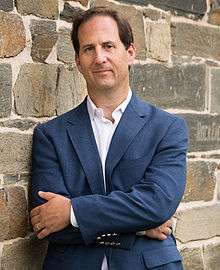Eric Lichtblau
| Eric Lichtblau | |
|---|---|
 | |
| Born |
1965 Syracuse, New York, United States |
| Occupation | Journalist, Author |
| Notable credit(s) | The New York Times, The Nazis Next Door, Bush's Law:The Remaking of American Justice |
Eric Lichtblau (born 1965) is a United States journalist and Washington bureau reporter for The New York Times.
Bio
Lichtblau was born in Syracuse, N.Y., and graduated from Cornell University in 1987 with majors in government and English. After college, Lichtblau did stints on the L.A. Times investigative team in Los Angeles and covered various law enforcement beats. Lichtblau worked at the Los Angeles Times for 15 years, where he covered the Justice Department in their Washington bureau between 1999 and 2000. He joined The New York Times in September 2002 as a correspondent covering the Justice Department. He and his wife live in the Washington D.C. area with their four children.[1]
Books
He is the author of Bush's Law: The Remaking of American Justice. With fellow New York Times reporter James Risen, Lichtblau was awarded a 2006 Pulitzer Prize for breaking the story of the National Security Agency's wiretapping program. Using groundbreaking research, Lichtblau's book was first to inform the American public that after 9/11, President George W. Bush had authorized the National Security Agency, in apparent contravention of federal wiretapping law, to eavesdrop on Americans without court warrants.[2]
In The Nazis Next Door: How America Became a Safe Haven for Hitler's Men, Lichtblau uncovered the full details of Operation Paper Clip, a story that had been carefully guarded by America's Central Intelligence Agency for over sixty years. Unknown to Americans, and fully aware of the monstrous crimes many had committed, the CIA provided a safe haven for thousands of Nazi scientists and spies after World War II. Most of the scientists recruited had worked on Hitler's V2 rocket project. Best known of the Nazi scientists was Wernher Von Braun, often described as "Father of Rocket Science."
The V2 rockets killed thousands of British and Belgian citizens during the War and ruthlessly exploited concentration camp prisoners for labor. CIA directors insisted America's dominance in space technology was far more important than prosecuting war criminals. The CIA helped other Nazi's gain access to the US to covertly collect information on Communists as part of an overzealous Cold War policy. Elizabeth Holtzman described the novel as a "fast paced, important book about the justice department's efforts to bring Nazi war criminals in the United States to justice that also uses recently declassified facts to expose the secret, reprehensible collaboration of U. S. intelligence agencies with those very Nazis." In both of his novels, Lichtblau used first rate research to uncover what many would consider abuses of power by government agencies.[3]
Lichtblau said in an interview that "Of all the survivors in the camps, only a few thousand came in the first year or so. A visa was a precious commodity, and there were immigration policymakers in Washington who were on record saying that they didn't think the Jews should be let in because they were "lazy people" or "entitled people" and they didn't want them in. But there were many, many thousands of Nazi collaborators who got visas to the U.S. while the survivors did not, even though they had been, for instance, the head of a Nazi concentration camp, the warden at a camp, or the secret police chief in Lithuania who signed the death warrants for people."[4]
Bibliography
- 2008: Bush's Law: The Remaking of American Justice (Pantheon, ISBN 0-375-42492-X)
- 2014: The Nazis Next Door: How America Became a Safe Haven for Hitler's Men (Houghton Mifflin Harcourt, ISBN 978-0547669199)
References
- ↑ "About Eric Lichtblau". Houghton Mifflin Harcourt. Retrieved 7 January 2015.
- ↑ Lichtblau, Eric (2008-03-26). "The Education of a 9/11 Reporter: The inside drama behind the Times' warrantless wiretapping story". Slate. Retrieved 2008-03-31.
- ↑ Lichtblau, Eric, (2015) The Nazis Next Door, How America Became a Save Haven for Hitler's Men, Published by Houghton, Mifflin, Harcourt, Boston
- ↑ "The Prosen People: Interview with Eric Lichtblau". Jewish Book Counsel. Retrieved 22 January 2016.